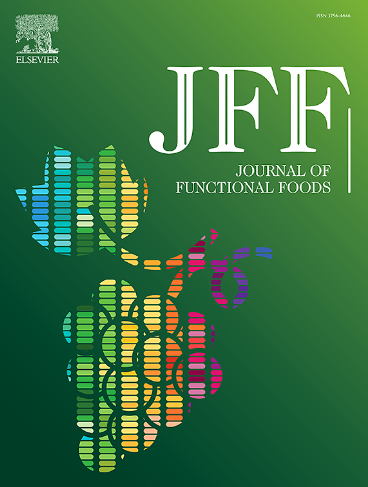EPA而非DHA通过激活肌肉IL-6/AMPK通路改善高脂饮食小鼠的全身IR
IF 3.8
2区 农林科学
Q2 FOOD SCIENCE & TECHNOLOGY
引用次数: 0
摘要
二十碳五烯酸(EPA)和二十二碳六烯酸(DHA)已被报道可改善胰岛素抵抗(IR),但其机制和差异尚不清楚。我们的研究结果表明,EPA和DHA激活了高脂肪饮食小鼠的肌肉IL-6并改善了IR。敲除肌肉IL-6后,EPA改善全身IR的作用被取消,但DHA的作用得以恢复;然而,EPA和DHA都没有通过激活AMPK来改善肌肉IR。此外,EPA和DHA激活IL-6,改善棕榈酸诱导的C2C12肌管细胞IR。在沉默IL-6后,EPA和DHA都不能通过激活肌管细胞中的AMPK来改善IR。一旦AMPK被抑制,EPA和DHA改善IR的作用都被取消。此外,IL-6激活AMPK并改善肌管细胞的IR。综上所述,EPA而非DHA改善全身IR主要是通过IL-6/AMPK信号通路减弱肌肉IR。本文章由计算机程序翻译,如有差异,请以英文原文为准。

EPA but not DHA improve systemic IR through activating muscle IL-6/AMPK pathway in high-fat diet-fed mice
Eicosapentaenoic acid (EPA) and docosahexaenoic acid (DHA) have been reported to improve insulin resistance (IR), but the mechanisms and differences remain unclear. Our results showed that EPA and DHA activated muscle IL-6 and improved IR in high-fat diet-fed mice. After knocking out muscle IL-6, the effect of EPA on improving systemic IR was abolished, but the effect of DHA was restored; however, neither EPA nor DHA improved muscle IR through activating AMPK. Furthermore, EPA and DHA activated IL-6 and improved palmitic acid-induced IR in C2C12 myotube cells. After silencing IL-6, neither EPA nor DHA improved IR through activating AMPK in myotube cells. Once AMPK was inhibited, the effect of EPA and DHA on improving IR was both abolished. Additionally, IL-6 activated AMPK and improved IR in myotube cells. In conclusion, EPA but not DHA improves systemic IR mainly due to attenuating muscle IR through IL-6/AMPK signaling pathway.
求助全文
通过发布文献求助,成功后即可免费获取论文全文。
去求助
来源期刊

Journal of Functional Foods
FOOD SCIENCE & TECHNOLOGY-
CiteScore
9.60
自引率
1.80%
发文量
428
审稿时长
76 days
期刊介绍:
Journal of Functional Foods continues with the same aims and scope, editorial team, submission system and rigorous peer review. We give authors the possibility to publish their top-quality papers in a well-established leading journal in the food and nutrition fields. The Journal will keep its rigorous criteria to screen high impact research addressing relevant scientific topics and performed by sound methodologies.
The Journal of Functional Foods aims to bring together the results of fundamental and applied research into healthy foods and biologically active food ingredients.
The Journal is centered in the specific area at the boundaries among food technology, nutrition and health welcoming papers having a good interdisciplinary approach. The Journal will cover the fields of plant bioactives; dietary fibre, probiotics; functional lipids; bioactive peptides; vitamins, minerals and botanicals and other dietary supplements. Nutritional and technological aspects related to the development of functional foods and beverages are of core interest to the journal. Experimental works dealing with food digestion, bioavailability of food bioactives and on the mechanisms by which foods and their components are able to modulate physiological parameters connected with disease prevention are of particular interest as well as those dealing with personalized nutrition and nutritional needs in pathological subjects.
 求助内容:
求助内容: 应助结果提醒方式:
应助结果提醒方式:


